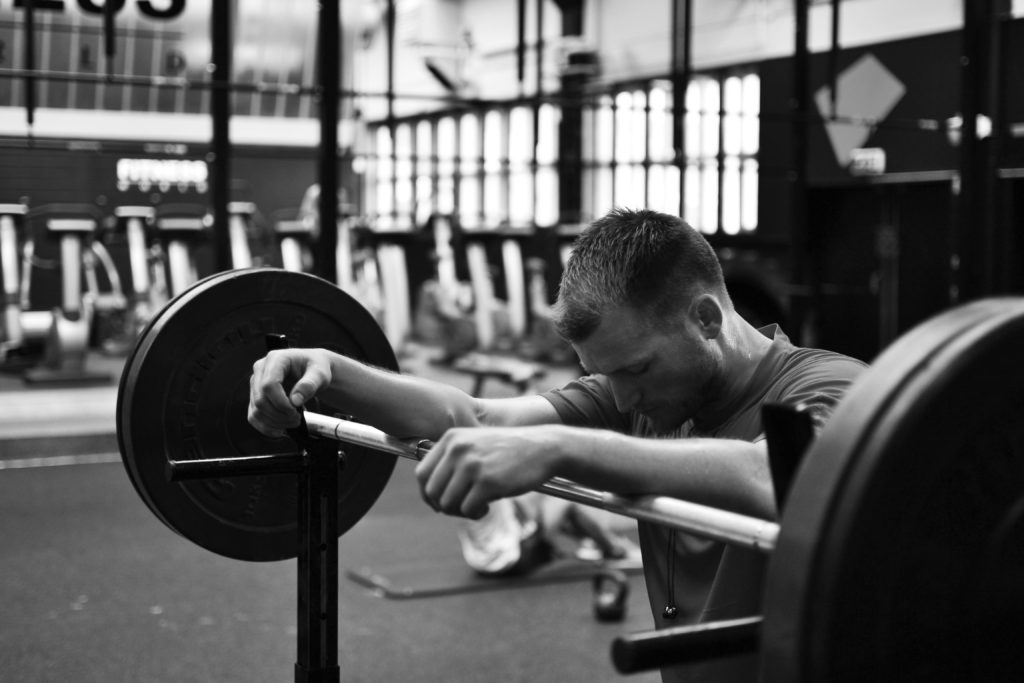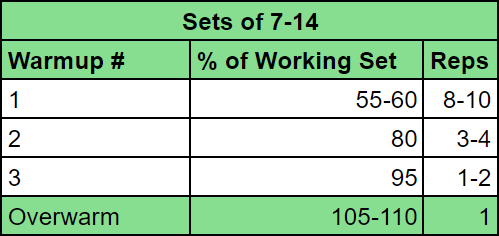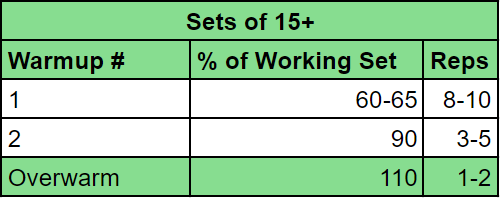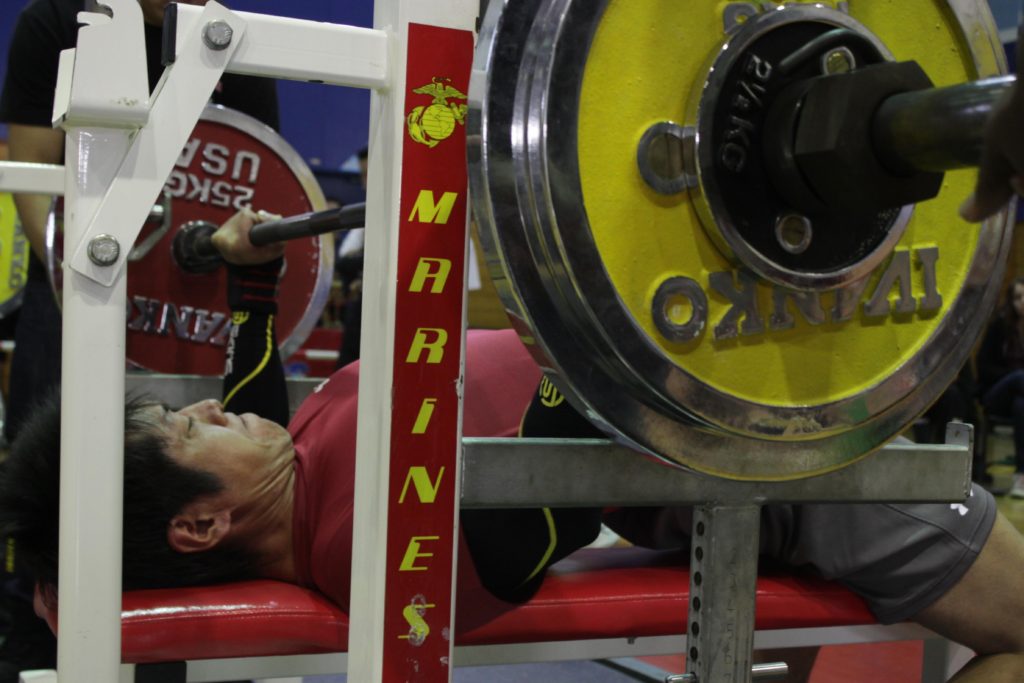There’s no perfect way to warm up for training. I’m going to give guidelines that are easy to apply.
They will help the majority of people in the majority of situations get the most out of their training. I’ll also explain when they may need to be adjusted slightly and how to do that.
If you’re a bit confused about the best way to warm u,p or you just want to try a different way give this method a shot.
This is a great place to start. As you get used to warming up you can always make small tweaks that work better for your situation.
Why Warm up for Training?
If you’re reading this you probably already believe that warming up is beneficial, so I’ll give a concise explanation.
The main benefits are to ready you for the actual training sets (the stuff that makes you bigger and stronger). It equips you both physically and pyschologically and reduces injury risk.

Warm ups get the blood flowing around your entire body (literally waming you up). More specific warm ups (such as lighter sets on the exercise you’re training) get blood flowing to the exact parts of connective tissue and muscle fibres you’ll be using on any given exercise.
This is the main reasons that the last 1-2 warm up sets should be done exactly as your main sets will be done. It allows your nervous system to “feel out” the heavy loads that you’re going to be using.
It ensures no massive shocks by going from no resistance straight to an extremely heavy weight. Imagine just walking into the gym and loading up your 3 rep max without doing anything else, it would feel like a house.
What to do before you get under the Bar
You can do mobility work as part of your warm up to prepare your body and nervous system for the positions you’ll be getting in under load. There are countless issues you could be experiencing. This article couldn’t possibly tackle them all so I’ll just focus on the other non specific aspects of a warm up.

In many cases, a properly done warm up can act as mobility work.
This can be exaggerated manipulating tempo and pausing in positions where you find that you’re particularly tight.
It’s usually a good idea to do some light cardio (can even just be a walk) to get blood flowing around your entire body and get your core temperature up a bit.
This isn’t always mandatory but in many situations it’s definitely beneficial.
What Weight and how many Reps?
I’ll use 100kg as an example for the working weight as it’s a nice round number.

If you were planning on doing sets of 4-5 with 100kg on the bench press your warmups may look like this:
50kg for 8 reps
65kg for 4 reps
80kg for 2 reps
95 kg for 1 rep
Overwarm (OPTIONAL) 105kg single @ RPE 5.5/6

If you were planning on doing sets of around 10 with 100kg on the bench press your warmups may look like this:
60kg for 8 reps
80kg for 3 reps
95 kg for 2 reps
Overwarm (OPTIONAL) 110 kg for 1 rep

If you were planning on doing sets of around 20 with 100kg on the bench press your warmups may look like this:
65kg for 10 reps
90kg for 5 reps
Overwarm (OPTIONAL) 110 kg for 2 reps
Depending on the rep range of the exercise I recommend slightly different progressions in warm up weight.
Many people like to do even lighter warm ups and start with the bar. That’s completely fine, I’m not saying you can’t do lighter warm ups.
I’m including the least amount that I believe will prepare you well for your working set. If you like to do more to practice technique or mobilise slightly more that’s completely fine too.
If you do just these sets with a high degree of focus you’ll be better prepared than most people who start lighter.
They might do more sets and reps but most lifters tend to just go through the motions. This artificially extends how much warming up you need.
The first warm up may seem heavy if you’re used to starting with the bar. Unless your body is an absolute train wreck you’ll be completely fine handling 35-45% of your max for your first warm up.

If you bench 140kg, starting with 70kg for a set of 8 (extreme high end of these recommendations) is really not an issue. As long as you focus on intent and positioning instead of just going through the motions you can get everything you need out of that warm up set without it fatiguing you.
As you can see the heavier that you lift relative to your max the more warm up sets are needed. As you get closer to your working sets the weight jumps and reps per set decrease
The idea is to keep both the RPE and reps low to minimise fatigue
Keeping just one low won’t accomplish this, Let’s use the example of 100kg for sets of 10 as the working set.
If someone kept just the reps low but not the rpe they might do 95kg for 10 reps as the final warm up. This is in this weird range of not quite being a working set (might be around 5-6 reps from failure) but it will definitely add fatigue and take away from the volume you can perform in this and future workouts (cumulative fatigue).
If they kept the reps low but not the rpe they might work up to a single with 135kg @ rpe 9.
This will add both stimulus and fatigue, but not stimulus and fatigue that was planned for in the context of the rest of the program.
This can absolutely be a viable method of programming. Here it was just added in with no thought to how it would affect the rest of the program.
Execution of Warm ups
Form is the focus .
Form is always important but on warm ups, the sets are easy enough that you don’t have to put much intensity in to complete smooth reps. On warm up sets you’re not worried about getting through the set and there isn’t as much intensity required. This extra focus can be put in to executing the warm up sets as well as you possibly can.
If you choose to do overwarms the hardest you’ll ever have to do is a single at RPE 6 (still 4 reps from failure) which is still going to be a smooth easy single.
No excuse for sloppy form here. The sets are easy enough that focusing heavily on form still leads to easy smooth lifts.
Tempo of Warm ups
Tempo or paused reps can be a useful tool to enhance the effectiveness of warm ups. Slowing down the speed (tempo reps) or pausing in different parts of the ROM can help get you into the groove of the movement better.
If you feel like there are certain parts of the ROM where you struggle to stay in position due to tightness/bad motor pattern habits, slowing the reps down or pausing in these position can be a great way to improve these issues. It acts as a form mobility work (pauses in the bottom of a squat with good position for example).
I’d always recommend doing at least the final warm up at a normal tempo if your working sets aren’t paused/tempo reps. As explained above part of the purpose of warm ups is to practice the technique of the working set.
Tempo is part of technique. If the way you produce your best performance is to maximally take advantage of the stretch reflex you should practice that using the same tempo on at least your final warm up. This is so that your main set isn’t the first time you’ve done it in that session.
If your working sets are supposed to be done at a tempo/paused I’m a fan of exaggerating it slightly on your last warmup (not overwarm). Pause for 0.5-1s longer, make the negative 0.5-1s longer etc.
The warm ups are set up so that even if you pause slightly longer on your final warm up it still won’t fatigue you. If your extended pause is actually an extended pause that’s great! The top set will feel better because you won’t have to pause it as long (essentially a different form of overwarm).
You always want to do your warm ups in a way to practice for your top set. The difference here is that going from a long pause to a slightly shorter pause isn’t really a change.
How the stretch reflex is used isn’t changed when extending a pause slightly. Going from a paused rep to a non paused rep changes the use of the stretch significantly.

Warming up for the 2nd or later Exercise per Muscle group
This is going to depend on how similar the exercises are, both in terms of movement pattern and also muscle groups used as prime movers.
When the exercises use the same muscle groups as prime movers, such as when going from a bench press to a fly for example the muscle in question is already warm and primed to produce force. The main purpose of the warm up here is to practice the technique of the second exerciseto get the most out of the working sets.
A good rule of thumb here is to do one warm up set where you do half the number of reps in the working set with 90% of the working weight.
In the vast majority of cases the second exercise for each muscle group is going to be at minimum 5 reps, 90% of that weight for 3 solid reps will be enough to practice the technique.
If you went from benching 110kg for sets of 6 to doing flat dumbell press with 50kg for sets of 8, 45kg for 4 reps would be your one and only warm up set.
If you don’t rest enough before the main set this may add a very slight amount of fatigue. Fortunately the most important work has been done fresh. You’ve obtained your main strength stimulus and any impairment to performance on the 2nd exercise would be so minor that it wouldn’t affect the hypertrophy stimulus from the sets.
If the exercise uses the same muscle groups but also includes slightly different ones, like going from a weighted dip to an incline dumbell press for example, you may have to do 2 warm ups sets before hitting your working sets.
Here a specific muscle group (upper chest) hasn’t been warmed up properly. When in doubt there’s no real harm doing an extra warm up set. Better to take an extra minute than to risk an injury or get a subpar set.
Why use Overwarm Singles?
Simply because it makes your working sets feel lighter if you’ve already felt a 5-10% heavier load. In some cases it’ll allow you to squeeze out an extra rep or 2 and as long as you don’t go too heavy and it won’t add noticeable fatigue.
Why only go 5-10 % heavier or to a single at RPE 5 or 6?. This is heavy enough to make the working set feel lighter but not hard enough to add significant fatigue. With heavier work pushing the overwarm heavier than this can lead to singles above RPE 6. This is hard enough to be considered a working set and will add a non insignicant amount of fatigue.
How heavy to push the overwarm would also depend on the lift. A more fatiguing lift such as a deadlift variation should probably not even go to a 6 on an overwarm set. This is due to how much disruption a heavy dead causes.
Even a single @ 6 will probably add a non insignificant amount of fatigue on a deadlift. However a single at 6 on bench wouldn’t be an issue in the vast majority of cases. Maybe not if you’re benching like 250kg/550lbs+. In this case your bench is heavy enough to disrupt your body like someone elses deadlift.

Again these are guidelines that cover the vast majority of situations. Whenever you make general guideline there will always be extreme outliers that need a slightly different approach.
Overwamrsaren’t mandatory by any means and may not be practical. They do make your workout longer but if the time is there I recommend using them when you can
Rest Periods between Warm up Sets
There is no universal rule here, they only need to be long enough for you to not have noticeable fatigue between sets. They will be much shorter than your warm ups between working sets. They can be 4-5 minutes or even longer on more taxing compounds.
This may only end up being the actual time required to change the weight on the bar. A mistake many people have made (including myself) is taking too long in between warm up sets. This causes the workout to be way longer than it needs to be for no benefit.
Warming up for Body weight Movements
Body weight movements are a tricky one, when you’re doing weighted calisthenics like weighted pull ups or dips you most likely won’t be able to go down to 50% of your working weight even if you’re quite strong.
Very few people do working sets on dips with their body weight attached. That’s how strong you need to be to use 50% of your max as your lightest warm up using the above guidelines. I rarely use my body weight attached for working sets and I’ve been training weighted dips as a main movement for the best part of a decade!
I’ve also never heard of someone that’s strong enough to do weighted pull up working sets with their body weight attached. Clearly we need a slightly different strategy here.
Some adjustments will have to be made for body weight movements including weighted calisthenics. Doing the same number of warm ups as you would on a barbell lift can be done, you just alter what you do.
You can utilise easier exercises using the same muscle groups for earlier warm ups. If you were warming up for sets of 10 on body weight pull ups you might do some lighter lat pull downs, assisted pull ups and a single rep pull up as the final warm up for example.
As a side note, barbell squats are also technically a weighted body weight movement. Most people are strong enough to where you don’t have to actually take into account your body weight when calculating the final warm ups like you’d have to do on pull ups or dips.
A reasonably trained lifter that may be able to squat 1.5-2x body weight (depending on a bunch of factors including style of squat). This means that the constant of your body weight doesn’t affect the warm up numbers much (especially since you’re not actually lifting your entire body weight when you do a body weight squat).
If you’re really concerned with how this affects squats, you can decrease the weight jumps in between warm ups slightly to compensate for the constant of your own body weight.
This same lifter may be able to do a pull up with 0.2-0.4x body weight attached or a dip with 0.6-0.8x body weight attached, here the constant of your body weight can really affect these numbers and you’re lifting a larger proportion of your entire weight when doing a body weight dip or pull up compared to a squat.
So how exactly would you warm up for a weighted body weight movement like weighted dips?
I’ll take the example of a 900kg lifter using 60kg for sets of around 10 reps as a primary exercise. The total weigh here is 150kg.
The above structure can be used with no alterations, 60% of the total weight would be body weight.
The warm up could be
BW (60%) for 8 reps
BW + 30kg (80%) for 3 reps
BW + 52.5kg (95%) for 2 reps
Overwarm (OPTIONAL) BW + 70kg (~107%) for 1 rep
This uses the warm up structure above, again these are guidelines, there isn’t one perfect way to warm up. As long as your weight progression isn’t wildly different from what’s above you’re probably doing okay.
Interested in coaching to take your progress to the next level?